Snart kan du genomföra ett köp med en selfie
Chefredaktör på ehandel.se Julius Gunnilstam skriver här intressant om senaste betallösning på nätet:
Vem blir först att implementera detta inom retail i Sverige??!!
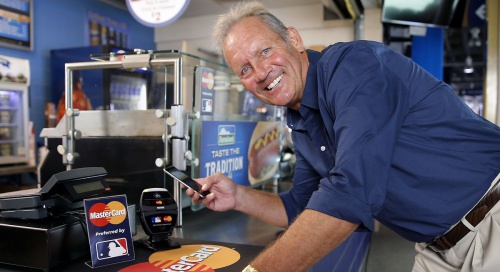
http://www.ehandel.se/Snart-kan-du-genomfora-ett-kop-med-en-selfie,5757.html
Inom kort kommer det vara möjligt att verifiera sina onlineköp med en selfie. Efter att Alibaba berättat om Smile to Pay kommer MasterCard med en liknande teknik.
I mars meddelade den kinesiska e-handelsjätten Alibaba att de ville få dig att betala med ett leende, bokstavligen. Man skulle verifiera sitt köp genom ansiktsigenkänning och tekniken kallade man Smile to Pay. Folk glömmer lätt sina lösenord men inte sitt ansikte förklarade Alibaba.
Detta var tydligen inte en helt galen idé för nu sägs MasterCard jobba på en liknande teknik. Du ska inte behöva le, vilket inte heller är ett krav med Alibabas teknik, men genom att ta en selfie, ett självporträtt, så ska du kunna verifiera och genomföra ett köp.
Tekniken skall utvecklas i samarbete med Google, Apple, Microsoft och Samsung och sägs vara säkrare än dagens lösenord.
Bilden sparas inte
Systemet, som är en del av en mobil app, kallas ID Check och kommer att skapa ett digitalt ”fingeravtryckt” av ditt ansikte som sedan kan jämföras med din nytagna selfie för att godkänna ett köp.
Företaget lovar dock att de inte kommer spara själva bilden av ditt ansikte. Det skall inte gå att återskapa bilden med den data som MasterCard kommer spara på sina servrar. Den mobila appen kommer även kräva att kunden blinkar för att utesluta att någon håller upp ett fotografi av användaren.
MasterCard hoppas att selfie-trenden kan leda till att den nya verifieringsmetoden blir populär. ID Check ska kunna användas både online och i fysiska butiker och förväntas rullas ut i slutet av året. Just nu är man redo att börja testa den nya appen på ett hundratal personer. På de telefoner som har en fingeravtrycksläsare kommer även möjligheten finnas att verifiera sitt köp med fingret istället för en selfie.
User and expert reviews are proven sales drivers for retailers
Why are reviews great for SEO?
Why are bad reviews valuable?
How to use reviews in navigation and on product pages?
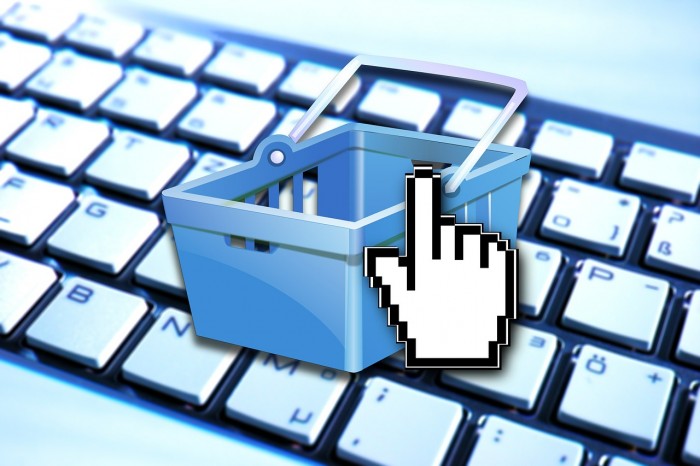
Almost 70% of todays customers read online reviews before making a purchase decision, which makes reviews essential for retailers and especially e-commerce sites. The majority of customers want to see reviews before deciding to make a purchase, in other words reviews are proven sales drivers.
User and expert reviews increase conversions. They usually eliminate any doubts potential customers could have about a product also helping product selection. People also seem to enjoy leaving reviews.
Statistics show that 49% of European consumers have reviewed products online, which proves that customers like to read, use and provide their opinions. According to Reevoo statistics, reviews in the product description means a huge increase in conversion rates. 63% of customers are more likely to make a purchase from a site, which has user, and or expert reviews. Site visitors/customers interacting with both reviews and customer questions and answers are 105% more likely to purchase while visiting, and spend 11% more than visitors who don’t interact with UGC (User-generated content)
Expert and consumer reviews are significantly more trusted (nearly 15 times more) than descriptions that come from manufacturers themselves. This is why reviews produce an average of almost 30% increase in conversion.
(According to a survey by US Internet users by online video review site EXPO)
Another big benefit is improved SEO.
Improving conversions and customer experience is usually the main purpose and focus when working with reviews,
but there are considerable SEO benefits as well:
Updated and unique content for search engines. Search engine spiders like unique updated content, and by including reviews we also obtain and show much more detailed, unique and relevant content.
The bigger the e-commerce retailer becomes the more products they need to display this usually leads to habits of using the same standard manufacturer descriptions and product specifications that are easily provided to them from the suppliers. User-generated content can differentiate a product page in the search results. This is essential as it makes information more useful for the customers, and also increases the chance of ranking highly in the SERPs.
A recent survey shows that 64% of consumers would read online reviews when purchasing technology items such as phones, games and pcs. Expert and consumer reviews are an increasingly important part of the purchase journey for online consumers. This also means that more consumers will be using the product name together with the word “review/rating” in their search. Working with reviews you have a better chance of picking up this traffic, which again means improved CTR. According to statistics from Distilled, this gives app. 20% increase in click-through rates.
Long tail targeting:
The additional content generated by expert and user reviews increases the chance of ranking well for long tail searches as well. When consumers leave reviews they usually use the same language that other consumers will use when searching for them. Long-tail search / targeting is the attempt to draw visitors who are searching on infrequent queries to a site. The long tail has a very compelling advantage since it’s where most of the traffic lies. Chris Anderson, editor of Wired, first observed the phenomenon when he noticed that the bulk of Amazon’s revenues came from a long tail of items, and not a few blockbuster items.
As many pages on a site as possible should feature expert and user reviews to maximize the opportunity to rank well for this content and capitalize on long tail traffic.
Why are bad reviews very valuable?
All reviews are valuable, and a mix of positive and negative reviews helps to improve consumer trust. Recent statistics from Reevoo suggests that the bad reviews actually improve overall conversions by 54%. Reevoo discovered that consumers reading bad reviews convert better, because paying such close attention means they are the ones more likely to be in purchase mode.
68% of consumers trust reviews more when they see both good and bad scores, while 30% suspect censorship or faked reviews when they don’t see any negative reviews on the page. (Of course too many bad reviews aren’t good for business) The benefits of bad reviews very much lies in the proportion between good and bad. The negative reviews make the positive ones more believable.
The beneficial number of bad reviews depends on age groups. 28% of the 45-54 year age group and 33% of 55-64 year olds would be deterred after reading two bad reviews, compared with just 10% of 18 to 24 year olds.
It also depends on the type of product.
Books, games or movies will often divide opinion, whereas reviews of electrical products, which highlight flaws, will be more likely to deter others. The outcome also depends on where the reviews are displayed and in which context.
It is optimal to work with a combination of expert reviews and consumer reviews. Here are some examples of how to attract consumer reviews:
A good method of getting enough customer reviews to make your product pages more persuasive for shoppers is to use a third party reviews provider, such as pricerunner or prisvis. This is a serious way to build up a good list of reliable reviews for product pages. These reviews are also authenticated, so customers know that the person leaving the review has actually purchased the product in question.
Sending an email after a customer has purchased an item to ask for a review is a also a good idea it is called post-purchase emails and can increase customer feedback by more than 200%.
Expert Reviews can be provided by various companies e.g. Testseek.com, which is one of world’s most complete databases for expert reviews of consumer related products. Testseek.com aggregate expert reviews from thousands high quality content web sites. Through partnerships Testseek.com also list review information from physical magazines.
An unbiased expert review is always trustworthy since the expert has greater knowledge and wider experience dealing with products within the field of his expertise.
How to present reviews and ratings.
It is essential to have many serious reviews, however it is important to organize the reviews so new shoppers can make sense of them.
According to UX expert Jared Spool, Amazon’s additional question: ”was this review helpful to you?” was responsible for $2.7bn of revenue each year. Asking this question, Amazon’s own customers helped sort what were the most important and sales driving reviews, which enabled Amazon to place the three most helpful reviews at the top. They mix positive and negative reviews, so shoppers get a balanced perspective.
Reviews can also help customers in their product selection. If you add a filter by user rating option it becomes a useful tool for customers. Use the ratings to offer the customers even better filter possibilities. Excellent filters are known to save time for customers and help them focus on the purchase without distraction, which is again a conversion improver.
Online reviews for in store customers.
Reviews are not only for online purchases. 70% of in store customers research online before heading to the store, or use their mobiles to find reviews (and compare prices) of the products they are considering while in the store. This means that in the future, more brick and mortar stores will urge customers to use online reviews as a sales driver, in the same way many retailers use staff recommendations.
By Charlotte Katz, retail sales amplifier.
Are you ready for Omni-Channel Retailing?
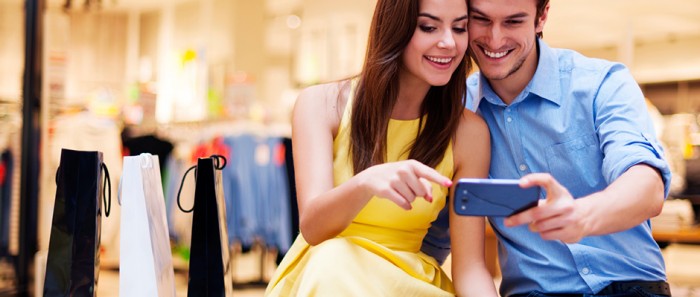
Read how I see the new business reality.
Business Strategy for Digization and Omni-Channel:
For business change to happen, corporations need to implement a holistic view of their business as a whole, rather than as siloed operations competing for revenue.
Executive Sponsorship: Adopting a CX strategy ( transform into a customer-centric corporation with Omni-Channel strategy starts with a boardroom meeting and executive sponsorship. Statistics consistently show that Omni-Channel shoppers outspend their single channel counterparts, but implementing an Omni-Channel strategy requires a significant investment. Make sure your company has defined executive sponsorship.
Clear Objectives: When setting business objectives, remember that Omni-Channel communication is more than delivering the same content across multiple channels. Real Omni-Channel is delivering a consistent and rewarding customer experience across all channels. E.g. promoting the brand promise, conversational tone, promotional offer and even company personality along with the content needed to satisfy the consumer. This often represents a cultural change where all departments must be reoriented to support whole company goals and not just goals benefiting individual departments. Adopters should create cross-functional teams to design and deploy more holistic and agile business processes.
Omni-Channel Objectives:
• Deliver consistent customer experiences from platform to platform, with continuity in offerings, branding, messaging and content.
• Create seamless customer journeys with cross-channel engagement continuity to contribute to the overall consumer experience.
• Enable consumers to access communication channels simultaneously and interchangeably while maintaining dialogue persistence, facilitating consumers to engage.
• Facilitate the latest technical devices for a seamless buying experience. SoMoLo (Social Mobile Local) devices and services, touch-based interactive signage, more engaging POS systems and beacons. Stay ahead of competition with the latest well tested technical systems.
CRM and Customer Service:
Establishing a 360-degree view of the customer experience is a prerequisite to delivering personalized and consistent communication. Omni-Channel success requires an underlying platform to act as the customer system of record and manage or facilitate all customer-facing processes. For most organizations this will be the CRM system. Omni-Channel customer service changes from a company-managed channel (normally the call and email centre) to also including social networks such as e.g. Facebook, Google+ and Twitter.
To be successful corporations must embrace Social CRM in order to support social customer service, peer based communities and cross-channel escalation. It is very important that the CRM application is well integrated with the ERP system in order to support customer inquiries. Customer experience is only as good as the people who deliver them. Education, training and coaching will be required.
Marketing and Business intelligence (BI):
Marketers need a unified marketing platform, integrated to the customer system, that will facilitate consumer online research to in-store purchases, permit consumers to manage their loyalty program from anywhere (online or in the store) and access new promotions across multiple channels simultaneously. On the ecommerce site, the email distribution, the social network pages, the mobile app and in stores whether at the POS, an information kiosk, interactive signage or on the floor via a tablet used in clienteling. Consumers now expect promotions based on who they are. It is also becoming extremely important to deliver the same offers and promotions across all channels. Omni-Channel delivers more actionable data to marketers – including purchase patterns, loyalty program behaviours, social media solidarity, personal preferences and website interactions. This way marketers can offer very relevant, personalized, contextual and channel-specific messaging and offers which facilitates revenue goals.
BI: Consumer analytics is necessary to transform into successful Omni-Channel performance. The corporations and marketers that best acquire Omni-Channel data and act upon that personalized information will be the winners.
Sales:
There are many Omni-Channel sales opportunities to address such as enabling a ”commerce anywhere” approach, an Omni-Channel shopping basket, personalized product recommendations, campaign offer automation or online ordering with in-store pickup or returns. Make your brands data and customer experience portable so that consumers can store it on their mobile device and take it with them. Encourage in-store scanning with a mobile app that not only downloads the item but also supports information and promotion that stays with the buyer during their shopping excursion.
Enabling Technology:
Corporations and retailers must deliver the right content and knowledge to the consumer, employee and engagement point whenever needed, as well as maintaining engagement while seamlessly interbreeding conversations across channels in real-time. Technology is important to provide the right data. Unifying online and offline/store systems and applications are a must and multiple customer databases will need to be adjusted. Using a customer system with MDM (mobile device management), better enables agile business strategies. Corporations and retailers must recognize the need of new technology strategies. SoMoLo (Social Mobile Local) devices, touch-based interactive signage and more engaging POS and beacon systems are just some of the future tools required.
Omni-Channel Benefits:
Omni-Channel strategy will improve customer experience, revenue, loyalty, business performance and profit. In a research report: ”Satisfying the Omni-Channel Consumers Whenever and Wherever They Shop”, IDC Insights found that while Multi-Channel shoppers spend 15 – 30% more than consumers who use only one channel, Omni-Channel shoppers will spend 15 – 30% more than Multi-Channel consumers and exhibit stronger brand loyalty, often influencing others to promote the brand. IDC research also found that consumers provided with a seamless experience across multiple channels shop more frequently and make more purchases across a broader number of product categories.
Another benefit of a well-defined Omni-Channel strategy is getting shoppers back into stores. Despite the predictions for the demise of brick-and-mortar stores, research continues to show that consumers still want the social interaction and instant gratification delivered with the in- store shopping experience. Research also shows that 60-70% of offline sales are now impacted by online research and digital offers. Clearly, online channels can be designed to get consumers into the stores. With a smart Omni-Channel strategy, one channel can drive another to promote channel-agnostic revenue goals.
Omni-Channel is Omnipresent and is no longer something to do in the future. Corporations and retailers who sit the sidelines will see their businesses deteriorate in equal proportion to the continued rise of Omni-Channel shoppers. Shoppers have more choices, competitors are only a click away and consumers publicly share their shopping experiences in social networks that magnify good or bad brand experience in a way that reaches thousands and stays in the public record indefinitely.
I am dedicated to your success and can project manage these cases for your company.
Please contact me at: charlotte@webshopkonsulten.com
+46707215212
Digital darwinisme pågår överallt – don´t repeat the Kodak Moment
Super spännande artikel av Karl Wig för e24.no – hoppas det går bra att läsa norska för det är högst läsvärt.
– Han kom bort og spurte om jeg ville selge min Apple Watch. Okay, sa jeg.
– Hvorfor selger du den?
– Jeg har en til.
Brian Solis (44) er mannen som må være i front og gir dårlig samvittighet til alle som henger etter. Han er verdenskjent futurist og digitalanalytiker i Altimeter. Han holder foredrag og har skrevet en bunke bøker, som har solgt i millioner, og trolig gitt akutt angst hos like mange bedriftsledere.
For Solis vil inspirere oss til å angripe fremtiden før det er for sent, før vi blir akterutseilt av dem som gjør det. Og det kan skje veldig, veldig snart.
– Hva er poenget med en nettside?
Denne uken dro Solis fra Silicon Valley til Oslo for å banke budskapet inn hos deltagere på Ehandelsforum-konferansen.
Noen av dem hadde kanskje håpet på å bli servert kjappe tips til hvordan å gjøre handlekurven i nettbutikken mer brukervennlig.
Nei, nei. Solis hadde ikke kommet fra Silicon Valley for slike småligheter.
– Hva er poenget med en nettside i 2015? De har ikke endret seg siden 1997! Du må være mer relevant, fastslo futuristen til tause gisp i salen.
De ble så servert salver som dette:
– Vi er i en virkelighet hvor forbrukerne ofte har større makt en merkevaren. Kommer vi ikke oss foran dem, kommer de foran oss. I hver eneste industri er det likt.
Og disse:
– Det skumle er at forstyrrelser skjer overalt. Vi tror det kommer fra våre nærmeste konkurrenter, mens det kommer fra steder man ikke aner. Som start-ups.
– Folk spør meg: «Brian, kan du gi meg en liste over justeringer vi bør gjøre?» Jeg sier «selvsagt kan jeg det, men da vil du bli som alle andre».
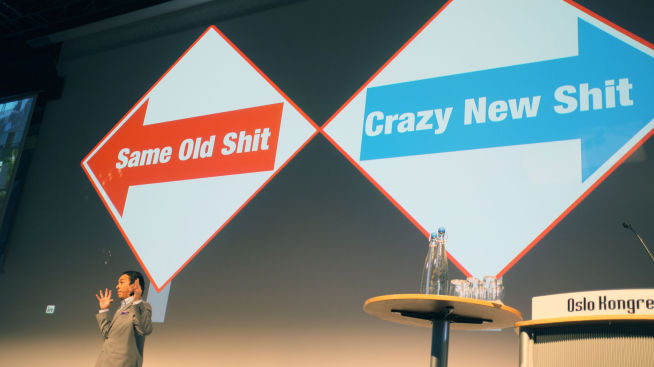
VEISKILLE: Brian Solis vil at du tar den til høyre.
Eierskap for fall
I 2010 slapp Solis den «komplette guiden for merkevarer og bedrifter for å bygge, dyrke og måle suksess på det nye internettet».
Det er altså fem år siden.
– Oh yeah. Spørsmålet jeg vet du skal stille nå, er hvor relevant den boken er i dag.
– Det stemmer.
– Den ble skrevet på et tidspunkt hvor teknologien begynte å menneskeliggjøre kundene. Du kunne begynne å lære om grupper, interesser, preferanser. I dag har det gitt liv til deleøkonomien, men også det vi kaller «the shut in economy», hvor alle tjenester kommer til deg.
– Det er avgjørende. Det er enormt! Det endrer ikke bare appene og tjenestene og duppedittene vi bruker. Det endrer forbrukersamfunnet totalt. Det endrer ideen om eierskap. Kan du leie mer enn du eier? Trenger du å kjøpe de tradisjonelle tingene lenger? Det skaper rystelser i en rekke industrier.
Kodak moment
I 1975 ble det digitale kameraet oppfunnet av Steve Sasson. Han var ingeniør i Kodak, det amerikanske selskapet hvis tilstedeværelse i den analoge fotografiverdenen var så kolossal at «Kodak moment» ble et akseptert uttrykk for å beskrive en hendelse i livet som fortjente å bli foreviget. På analog film, selvsagt.
I dag har «Kodak moment» fått en ny mening: Når et selskap nekter å gi slipp på sin gamle storhetstid, mens resten av verden går inn i en ny.
– Det er øyeblikket når en bedrift går glipp av hvordan kundene deres endrer seg. Kodak valgte å ikke omstille seg, for de fryktet at digitalkameraer ville kannibalisere film, sier Solis.
Kodak fikk på en måte rett, men skulle trolig hatt noen digitalkameraer som kunne kannibalisere egne filmruller. I stedet kom kannibalene fra andre hold. De hadde navn som Canon og Nikon.
9. januar 2012 begjærte Kodak seg konkurs.
Brian Solis ser «Kodak Moments» over alt. Han kaller det «digital darwinisme».
– Konsumentene forandrer seg, mens bedriftene driver som før. Digital darwinisme pågår overalt, i alle land. Det er supertrist! sier Solis og starter oppramsingen:
– I USA har vi RadioShack, Blackberry, Bestbuy, en drøss av detaljhandler. Du har bilprodusenter som trues av Tesla, og bilforhandlere som trues av Tesla og Apples direktesalgsmodell.
– Og i Genève i Sveits vil klokkeprodusenter gå konkurs fordi folk begynner å tenke at de bare trenger en smartklokke.
Den nye deleøkonomien
Men det er ikke bare selskaper som rammes av disruptive teknologier. Det er hele industrier, ifølge Solis. Som taxinæringen. Solis sier taxibransjens omsetning er ned 60 prosent i hans hjemby San Francisco, ene og alene på grunn av Uber.
– Det er trist for taxiene. Men ingen i San Francisco sa noensinne at «jeg elsker å kjøre taxi».
– Og det er jo ikke slik at taxi-industrien ikke hadde muligheten til å fornye seg i, tja, jeg vet ikke … 100 år?
Taxinæringens Kodak-øyeblikk går hånd i hånd med det som ifølge Solis er blant de største trendene akkurat nå: Den nye delingsøkonomien.
Folk vil kjøre hverandre. Folk dropper hoteller og bor hos hverandre.
– Respekten for eierskap er dalende. Man ser det i musikken. Folk vil kjøpe mindre ting. Og så får vi disse nye delebaserte tjenestene som Uber og Airbnb, og det skapes en ny virkelighet.
Generasjon C
Og i den nye virkeligheten sitter en ny gruppe konsumenter som Solis kaller Generasjon C.
– De er fenomenale. De er folk som alltid er på. De som går på fest og sitter på mobilen. Vi andre sier «se, dette er problemet med dagens samfunn. Verden går forbi mens alle er på telefonen sin». Men vi må forstå hva som ligger bak skjermen. De skaper sin egen kultur, snakker i memer og animerte GIFer.
Og i hopetall kan de altså skape de store selskapers frykt: Kodak-øyeblikk.
– Kodak-øyeblikk kommer i forskjellige stadier. Det er ikke bare stadiet «å nei, vi mister alt». Det handler også om å gradvis glippe forretningsmuligheter, sier Solis og fortsetter:
– Microsoft glapp veldig mye under Steve Ballmers ledelse. Når den første iPhonen kom ut, sa han at «ingen vil ha en telefon uten knapper.» Han lo. Han var så pompøs! Og Microsoft mistet hele sin mobile strategi. Ballmer så ikke den digitale forbrukeren, hevder Solis.
– Zuckerberg er som Steve Jobs
Han har langt mer sansen for Facebook-sjef Mark Zuckerberg.
– Zuckerberg er smart. Han er som Steve Jobs: Dytter alltid folkene sine fremover. Hver gang de lanserer noe, blir folk forbanna. «Å nei, de endrer algoritmen sin». «Å nei, de gjør Messenger til en egen app.». Det de gjør, er å fornye seg i takt med hvordan de ser verden fornye seg.
– Vil de fortsatt være med om 10 år?
– Det må de. Aksjonærene krever det. Og så lenge de fortsetter å streve for å holde seg relevante, vil de forbli relevante.
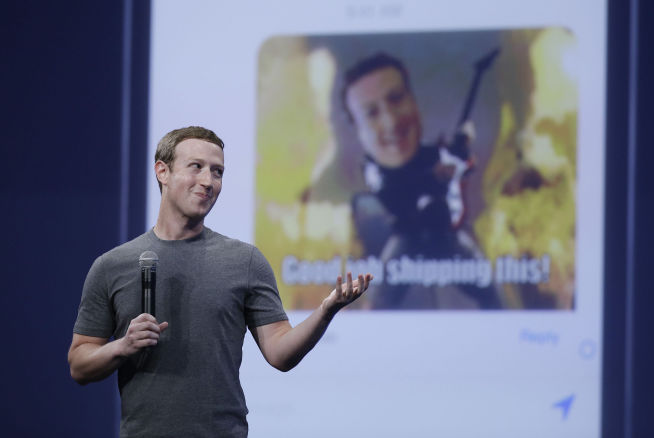
FÅR SKRYT: Facebook-sjef Mark Zuckerberg er fremtidsrettet, mener Solis. FOTO: ERIC RISBERG AP
Derimot synes Solis mange bedrifter bruker Facebook og andre sosiale medier feil.
– De ser på det som ren teknologi. De vil legge ut noe på Facebook for å få delinger og trafikk til siden. Men det er ikke hva sosiale medier handler om. Sosiale medier er egne samfunn. Det betyr at du må være del av samfunnet.
– Du kan ikke bare lage en konto og legge ut stoff, for det blir enveis kommunikasjon. Det er den største feilen bedrifter gjør.
Du vil ikke tro katt nummer 11
Solis har selv gått på journalistskole og sier journalistikken står hans hjerte nær. Men det er en ny æra – en æra hvor nyhetene står i fare for å miste sin relevans i møtet med Generasjon C.
– Man konkurrerer i æraen til Buzzfeed og alle disse stedene hvor forbrukerne får de utroligste overskrifter: «Denne personen mister bilen sin, men det som skjer etterpå vil forandre hennes liv!»
Solis grubler frem en til:
– «Disse 27 kattene har hatt en verre dag enn deg. Nummer 11 vil inspirere deg til å endre fremtiden din!» Det er spinnvilt. Og så går du inn i artikkelen, og det er veldig lite tekst, og desto mer GIFer og animerte videoer. Konsumentene drilles i å ta inn informasjon annerledes. Noen mener det er galt, men det er faktisk blant de mest intelligente strategiene for å involvere leserne. Buzzfeed er utrolig glupe på psykologi.
– Det er det som er så frustrerende for oldschool-redaktører. De har en mal for hvordan alt skal gjøres, men den er kun er tilrettelagt for lesing, men ikke deling. Buzzfeed får oss til å gjøre begge deler. Det er det jeg selv prøver å gjøre med alt jeg skriver.
Det neste store
Solis mener bedrifter tynges av ledere som ikke tør å ta krevende fornyingsbeslutninger. Og av en bedriftsstruktur som er satt i stein.
– Det er sjeldent at ledere utviser slikt lederskap. Og de som rammes av den digitale darwinismen, ser den ofte ikke komme.
Han mener flere bedrifter bør åpne opp sine egne innovasjonsavdelinger som tester ut ny teknologi og holder seg i front.
– Tenk som forbrukerne og oppfør deg som et start up, oppsummerer Solis.
Selv tror han den neste store trenden blir virtuelle virkelighetsopplevelser. Han snakker engasjert om Microsofts nyvinning Hololens. Teknologien ble nylig vist frem på spillmessen E3, ved at det populære dataspillet Minecraft ble prosjektert ut på et bord i all sin blomst.
– Deltagerne ble servert en full 3D-verden på bordet. Alle freaket ut. Det er utrolig! Tenk på de virtuelle reiseopplevelsene du kan skape. Folk vil betale for opplevelser, og dette er ting som kan endrer hvordan vi opplever livet, sier Solis.
Og smiler:
– Det er mange forstyrrelser på vei.
Sweden has come the furthest in Scandinavian omni-channel ventures
This study provides answers to how far 30 of the largest retailers in Sweden, Norway and Denmark have come in their omni-channel ventures. Avensia has created 16 fundamental omni-channel criteria. Depending on whether the retailer fulfill the criteria or not they’re awarded with a point. The points are converted into an index where 100 percent means they have answered “yes” in every criteria and 0 percent means that they have answered “no” in every criteria. Scoring 80 percent and above declares the company omni-channel ready.
The investigated retailers are then compared against each other, both individually, nationally and by industry. From the analysis Avensia has drawn conclusions about which companies and industries that are the best and worst, and what needs to be improved in the future. The survey is conducted by Yougov on behalf of Avensia
Avensia is the leading e-commerce expert company in the Nordics. Since 1998 the company has delivered complete business solutions for retailers with high aspirations and demands on their business. With experience from more than 100 major e-commerce projects Avensia provides services that reaches well beyond just the implementation, but also strategy, design and business development.
The customers of Avensia are European based and operating in both the B2C and B2B, in all industries from sports and fashion to manufacturing. Avensia employs more than 100 e-commerce experts at their offices in Lund, Helsingborg, Stockholm, Copenhagen, Oslo and Cebu.
Method
Prior to the survey 16 different omni-channel criteria were compiled together with a list of 30 of the largest retailers from each Scandinavian country. The companies were divided into categories; Consumer Electronics, Furniture and Furnishings, Clothing and Footwear, and Other. Each of the 16 omni-channel criteria was designed as a question and answered with a “yes” or “no”. The survey was conducted by Yougov through observations during the period of 9th April – 8th June 2015. The observations were made through the companies’ websites and was supplemented by telephone interviews.
The omni-channel criteria that were used in the survey are summarized in Appendix 1. The answers have been compiled in a matrix. The percentage of positive responses in relation to the 16 criteria constitute the omni-channel index. 100 percent indicates that every criteria has been answered with a “yes” whilst 0 percent indicates that every criteria has been answered with a “no”. Scoring above 80 percent in the index indicates that the company can be classed as omni-channel ready. Some of the criteria has changed since last year to make the measurement more accurate.
Selection
The selection is based on well-known retailers that operate in each country’s market. The goal was to have at least four companies per sector. In order to make the research as thorough as possible the list of companies have been revised to 30. Some of the companies are operating in two or all of the investigated countries and has therefore been prioritized to look into differences in the organizations across borders.
The survey is mainly conducted by observations but has been supplemented by interviews when answers have been unclear. The respondents are either E-Commerce Managers, Omni-Channel Manager, Sales Managers or COOs.
Sweden
Sweden has the best overall score of the Scandinavian countries. There are several strong retailers and Sweden is considered the most mature omni-channel nation amongst the Scandinavian countries. Only 2 of the examined 30 retailers score above 80 and can be called omni-channel ready. Those companies are colored in green. There are some other companies that are starting to reach omni-channel maturity but still have a few steps left. Those are colored in yellow. The red lined companies are far behind average. Those companies are defined as omni-channel laggards.
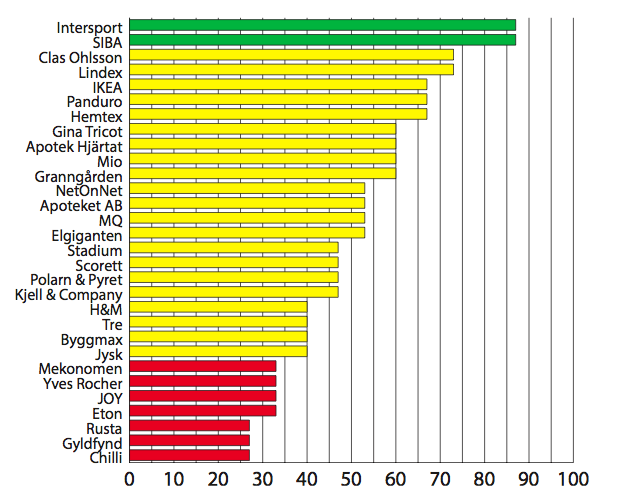
These graphs compare the different industries. The black bar describes the industry’s average score and the green, yellow and red describes the company’s success in each industry. The most successful industry in Sweden is the consumer electronics industry, with one of the obvious leaders in the business, SIBA. Consumer electronics have proven to be great products for online commerce because of the precision in product specifications, which makes it simple to measure and compare without seeing or touching it. This along with a highly competitive industry has accelerated the omni-channel strategies making these companies top the list.
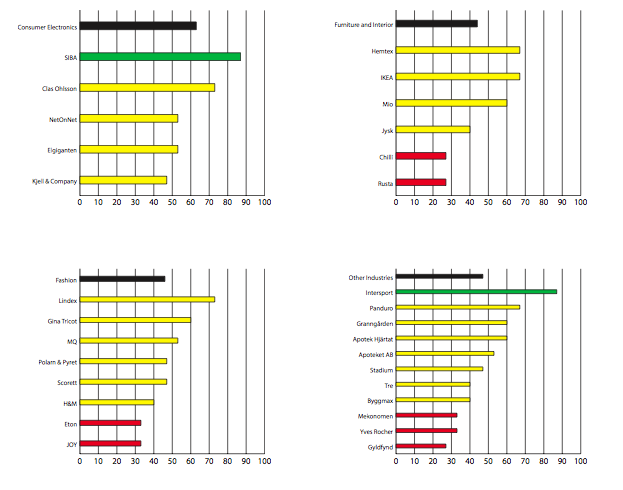
Norway
None of the examined Norwegian retailers are omni-channel ready. Norway is also the country with the most omni-channel laggards. There is lots of potential and significant improvement to be made in the Norwegian retailers omni-channel ventures. There are some other companies that are starting to reach omni-channel maturity but still have a few steps left. Those are colored in yellow. The red lined companies are far behind average. We call these companies omni-channel laggards.
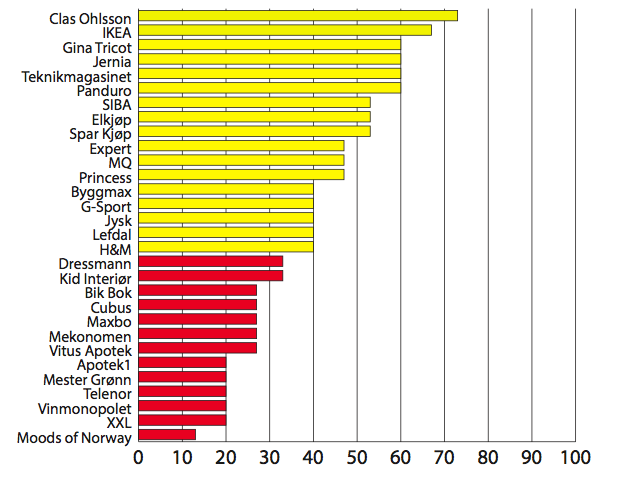
Industries
These graphs compare the different industries. The black bar describes the industry’s average score and the green, yellow and red describes the company’s success in each industry. The most successful industry in Norway is the consumer electronics industry.
SIBA which is the leader in Sweden is here falling behind both Clas Ohlson and Teknikmagasinet. Consumer electronics has proven to be great products for online commerce because of the preciseness in product specifications, which makes it simple to measure and compare without seeing or touching it. This along with a highly competitive industry has accelerated the omni-channel strategies making these companies top the list.
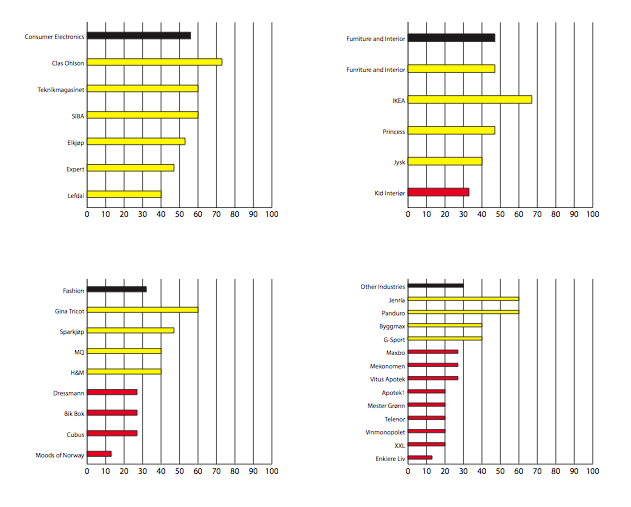
Denmark
Denmark is the second strongest nation in Scandinavia. Only 1 of the examined 30 retailers score above 80 and can be called omni-channel ready. Those companies are colored in green. There are some other companies that are starting to reach omni- channel maturity but still have a few steps left. Those are colored in yellow. The red lined companies are far behind average. We call these companies omni-channel laggards.
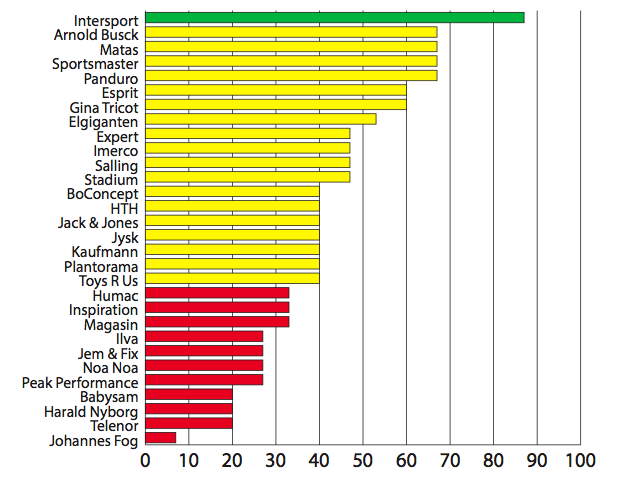
Industries
These graphs compare the different industries. The black bar describes the industry’s average score and the green, yellow and red describes the company’s success in each industry. There is no significant difference between the success in the different industries but the fashion industry is falling a bit short compared to the others.
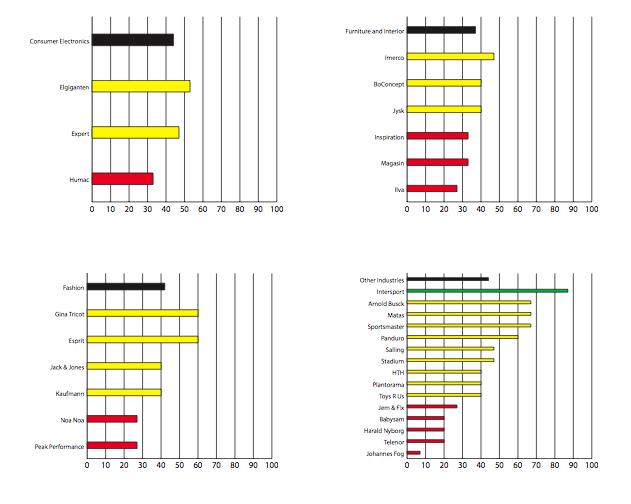
“For us at Intersport, our omni-channel venture has been about finding a formula where e-commerce and physical stores can help each other instead of competing. It has been a great challenge to get everyone in the organization to pull together and there has been a lot of work behind the change. Therefore we are very happy that this research really proves how far we have come”
– Daniel Anvell, COO at Intersport Sweden
”For us at SIBA, the customer is always in focus. A way for us to prove that we are responsive to their needs is through our distinctive omni-channel strategy. Our customers do not differentiate between channels but chooses the channel depending on their need in a “here and now” perspective. It’s therefore important that the customer recognizes SIBA in all channels and get offered the same good service in all encounters with our company”. – Susanne Ehnbåge, CEO at SIBA Sweden
Omni-Channel Criteria
This section shows the percentage of retailers in each country that fulfilled each criteria. Bricks and mortar is described below as B&M.
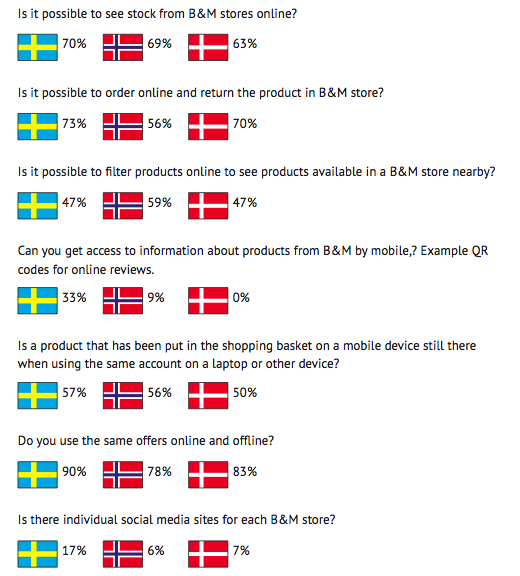
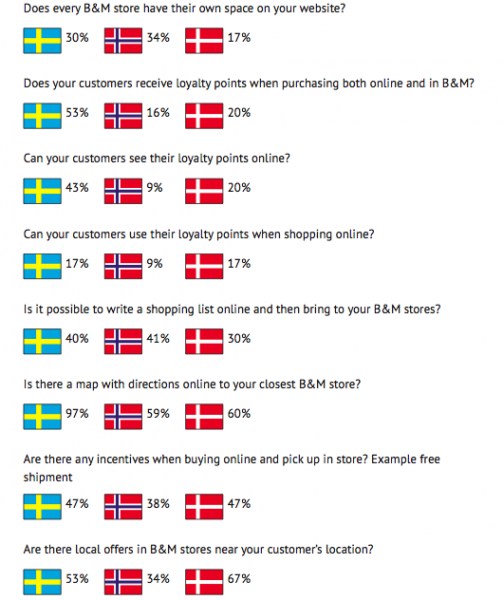
Conclusion
Building on last year’s report there has been a great development in the retail business. Last year none of the examined companies was declared omni-channel ready but this year there are three, two of them in Sweden and one in Denmark. The conclusion, when comparing the Scandinavian countries to each other, is that Sweden has come the furthest in their omni-channel ventures. Denmark is in second place with and Norway is the country that is falling behind.
Looking at the different industries we can see that consumer electronics is the strongest, although there is not by much.
All in all the results are much stronger this year than the last. Three companies were declared omni-channel ready: Intersport Sweden, SIBA Sweden and Intersport Denmark. Intersport Sweden and Interport Denmark are different organizations and do not share the same strategy which makes it interesting to see that they had a similar score. SIBA had a better score in Sweden than they had in Norway where Clas Ohlson was the strongest retailer.
Smart Retail Solutions That Change Ecommerce
”When all of these things come together in retail, you can really start to foster an experience for shoppers like they’ve never had before, and you can expect increased sales, conversions and ultimately, profits for your efforts” Read the following by John Waldron:
Smart retail is a term used to describe a set of smart technologies that are designed to give the consumer a greater, faster, safer and smarter experience when shopping. A world in which nearly everybody now carries around a smart device – i.e. the smartphone – is what has enabled this revolution in retail. It can be used to house online stores, as a catalog and directory for ‘real’ stores, and now increasingly as a direct means of payment for goods and services.
The Internet Of Things
Everything around us is becoming increasingly interconnected through technology. Sensors (such as iBeacons – see below) can be placed onto almost anything, and can connect any number of devices together in some very powerful and innovative ways.
If you’ve been shopping around for car insurance recently, then you may be aware of such a thing as Black Box Insurance. This is where sensors are placed in cars to allow insurance companies to link policy premiums to actual data on where and how well the car is being driven. In hospitals, there are even sensors that are being placed in teddy bears to monitor the health of sick children in discreet and non-threatening ways.

https://netguru.co/blog/smart-retail-solutions-that-change
What if your car was guarded by a small sensor?
But this is only scratching the surface of what is being made possible by the Internet Of Things. According to McKinsey, these disruptive technologies are forecast to have a $6.2 trillion effect on the economy by 2025. And one of the key industries that this will impact will be retail.
Smart retail is something that the world is now waking up to. In-store mobile marketing is becoming increasingly more sophisticated, and is being used more-and-more by retailers around the globe.
If you haven’t moved your store into the exciting new world of smart retail already, then perhaps now is the time to start considering how you can implement the technologies to make it happen – and it isn’t as hard nor even as expensive as you might think. There are, essentially, four elements to smart retail – ecommerce, beacons, smartphones and smart point of sale (POS).
Let’s take a look at these four things individually and consider how you might implement them into your business to give your customers the smart retailing experience that will make them come back again and again.
Ecommerce
It’s not enough to just have a shop on the high street – you need to be online as well. And, although it’s possible in theory to create a smart shopping experience for your in-store customers without also selling your goods online, to really make the most out of your efforts, then your best bet is to set up an online storefront. Thankfully, this couldn’t be simpler. Spree Commerce is an open-source Ruby on Rails based ecommerce platform that allows you to get an e-shop up and running quickly, efficiently and customized to your requirements. You can start building your shop right away, in fact. Spree’s BSD licence means that no matter the size of your business, you can start using Spree immediately for commercial purposes without having to pay a licence fee.
Spree is also one of the easiest and most reliable frameworks used today by developers. Based on Ruby on Rails, it is favored all over the web because of its simplicity and high quality. You can either choose from a number of high functioning and high quality themes to build your store, or, you can start completely from scratch with a custom-built e-shop to meet your exact requirements.
Either way, when thinking about creating a smart retail experience for your customers, it’s on your online store where you’ll be showcasing your products in all their glory. Full product descriptions, lots of images with the products being used in context, and perhaps even some promotional video shorts is what you want. Here is where your customers will be directed when they come into your shop and start browsing your shelves. How will this happen? You will strategically insert beacons into your store. What are beacons? Keep reading to find out.
iBeacons
iBeacons are small smart technology devices that can be attached to anything, anywhere. When a customer comes in close proximity to them, they broadcast tiny radio signals, which a user’s smartphone can receive and interpret. If you were selling digital cameras on one of your shelves, for instance, you could stick an iBeacon underneath, and, when a customer comes nearby, a notification will be automatically sent to that person’s smartphone. If clicked, the user will be directed right to your online store where the product specifications, pictures and pricing can all be displayed.
The great thing about iBeacons is that they create additional value for shoppers while they are in your store. And people are already turning to their smartphones to help them with their shopping experiences. A recent survey commissioned by Google found that more than 66% of smartphone users are already using their phones to help them shop and make purchasing decisions when in a physical, bricks and mortar, store.
iBeacons act like digital signs, and the power of these is that they can deliver the right message, at the right time, in the right place, to the right person. They are true innovations to the retail experience, and something that every smart retailer should have in their arsenal.
Smartphones and Apps
For the iBeacons to work, then the smart retailer needs at least one if not a suite of smart apps that consumers can download onto their smartphones. These are already being successfully used by pioneering retailers such as Timberland, Alex and Ani and Kenneth Cole. When customers walk into these stores, the beacons immediately deliver a push notification with a personalized greeting and an exclusive offer.

https://netguru.co/blog/smart-retail-solutions-that-change
Why not do a shopping haul by a cup of coffee, with just a smartphone in your hand?
According to GIGAOM,
“over 90 percent of surveyed shoppers who visited Kenneth Cole, Timberland and Alex and Ani in New York and Boston during their pilots of this technology said they would be highly likely or likely to use an in-store mobile experience again. These retailers reported a 75 percent open rate for in-store personalized offers and an impressive 35 percent conversion rate, meaning a substantial amount of shoppers not only appreciated the personalized offers but also acted on them.”
Smart retailing is all about smart devices and smart technology – by connecting smartphone to in-store beacons the whole shopping experience for your customers can suddenly explode into something truly sensational, smart, and very, very cool indeed.
POS
Aside from these personalized shopping opportunities that the combination of online stores, iBeacons and smartphones enable, there is one further innovation to complete the smart retailing experience for the consumer – point of sale (POS) technology that allows consumers to pay for their goods quickly, safely and smartly.
Apple Pay is the big one that came out earlier this year. Using either your iPhone, Apple Watch or iPad, consumers now have the ability to pay for their purchases by simply presenting their device to in-store contactless readers with their fingers on Touch ID.
But Apple has even further innovations than that. The “Apple Store Experience”, as it has become known, has earned a reputation as being one of the most effective in retail. Store associates are able to service and check out customers no matter where they are in the store, creating mobile POS that eliminates long checkout lines, and of course cut down on lost sales due to walkouts.

https://netguru.co/blog/smart-retail-solutions-that-change
With POS, queues at your brick-and-mortar store will become a thing of the past.
One of the beauties of implementing such a system into your business is that you can also use mobile POS devices to sell products outside of the four walls of your actual shop. Consider the opportunity for kiosks, pop-up stores or stalls at special events. Indeed, the great thing about smart retailing is that it can be done anywhere – after all, your customers will carry their smartphones around with them wherever they go, so bring your end of the smart technology to them, and there will be literally no boundaries to the smart retail experience.
Constant Connections
If you start with a strong ecommerce presence, then there’s really no limit to what you can achieve in terms of the smart shopping experience for the customer. UsingSpree, you can create a visually brilliant online store that contains and catalogues every single piece of information that a customer could possibly need to make an informed purchase. But don’t stop there. You want even your walk-in customers to access this site, and by strategically placing iBeacons around your store, you can automatically direct your customers to the information that they need, and the message that you want them to have. Apps make this possible, and by using something like Estimote you can create contextually rich mobile experiences for your in-store customers who come within close proximity to your beacons. Finally, make the smart shopping experience complete by offering a smart payment service – and this can be implemented directly into your Spree e-shop as well as your high street store.
When all of these things come together in retail, you can really start to foster an experience for shoppers like they’ve never had before, and you can expect increased sales, conversions and ultimately, profits for your efforts.

https://twitter.com/JohnWaldron_
Läs om marknadsföring med emoji och stickers – Asien visar vägen
Bris, Världsnaturfonden WWF och Coca Cola har under våren lanserat olika emoji-kampanjer på den europeiska marknaden. Fenomenet med emojis kommer från början från Japan, och i Asien är det vanligt att företag kommunicerar med både emojis och virtuella stickers i sin marknadsföring. Vårens kampanjer tyder på att trenden är på väg att etablera sig även i Sverige.
Sex miljarder emojis och stickers skickas via meddelandeappar varje dag, enligt en analys genomförd av startupföretaget Swyftkey. När Apple lanserade operativsystemuppdateringen IOS 8.3 för några månader sedan var det utökningen avmer inkluderande emojis som de tryckte på i sin marknadsföring. En av Instagrams senaste stora nyheter var att det nu går att hashtagga emojis. I maj beskrev The Telegraph emojis som Storbritanniens snabbast växande språk. Vissa går så långt som att kalla det för världens första globala språk.
Bris, Barnens rätt i samhället, är aktuella med kampanjen Abused Emojis. Via en mobilapp får användaren ett tangentbord med emojis föreställande barn som fart illa, detta för att enklare kunna kommunicera om och flagga för svåra situationer. Kommunikationschefen Silvia Ernhagen berättar om valet att kommunicera med just emojis:
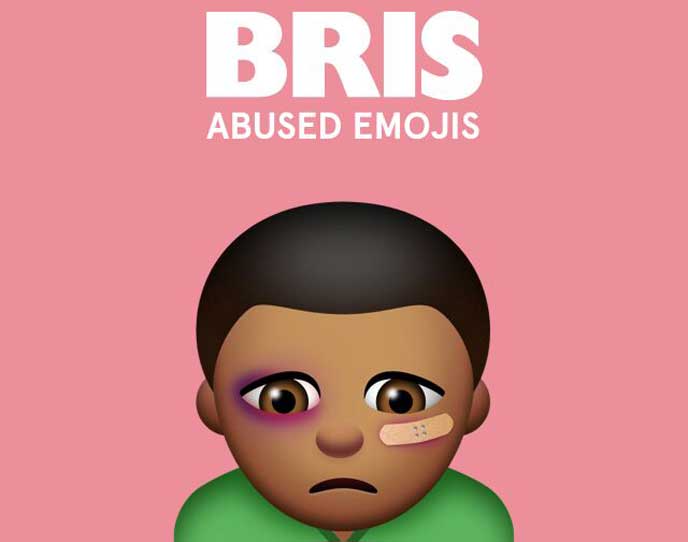
Bris använder sig av emojis för att uppmärksamma barn som far illa i sin senaste kampanj.
”Vi har kontakt med tusentals barn varje år och vi vet att det inte alltid är lätt att sätta ord på svåra känslor. Ibland är det lättare att använda symboler och bilder för att uttrycka sig vilket är en av anledningarna till att vi tagit fram appen. Att använda emojisar i kommunikationen är numera naturligt för barn och unga och för Bris är det viktigt att visa att allt går att prata om, även det svåra.
– Många barn och unga har hört av sig och sagt att de verkligen uppskattar initiativet. Några dagar efter lanseringen låg appen trea på svenska Appstore. Vi har marknadsfört den bland annat genom Instagram och fått stor draghjälp av personer som har många följare. Vi har också fått ett väldigt stort genomslag i media både här hemma och internationellt och fått positiva reaktioner från psykologer, socionomer och andra som träffar barn och unga som behöver stöd. Vi är väldigt glada för att vi fått ett sådant fint genomslag.
Världsnaturfonden WWF lanserade i maj en Twitterkampanj som sprider sig snabbt under namnet #endangeredemojis. Twittrare uppmanas att dela emojis föreställande 17 olika utrotningshotade djurarter, däribland en jättepanda och en blåval, för att öka medvetenheten om djurens situation. Mariann Eriksson, Marknadschef på WWF i Sverige, berättar om bakgrunden till kampanjen:
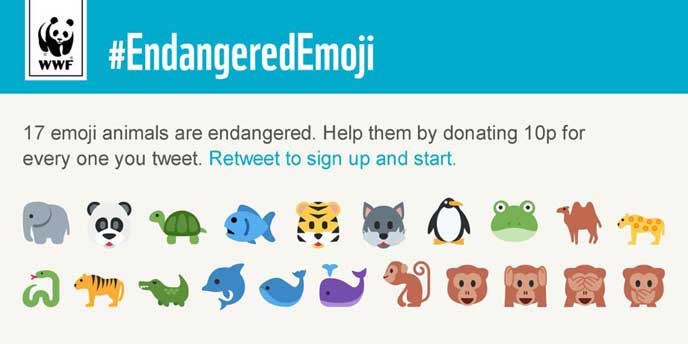
WWF använder sig av emojis för att uppmärksamma 17 olika djurarter som hotas av utrotning.
– Vi upptäckte att av de emojis som finns på Twitter är 17 stycken utrotningshotade arter. Sedan emojis integrerades på Twitter i april 2014 har de använts över 202 miljoner gånger. Vår idé är att omvandla användandet av emojis till donationer. Kampanjen är upplagd så att alla som retweetar WWF:s tweet om de 17 utrotningshotade arterna får en startpott som i lokalvaluta motsvarar 0,10 euro. I slutet av varje månad får dessa personer en summering av hur många gånger de har använt dessa emoijs och kan besluta om hur mycket pengar de vill donera.
I Asien är i dag även stickers, en större variant av emojis, vanligt förekommande i kommunikation mellan människor och används på populära chattappar som Line (Japan), Wechat (Kina), Kakao Talk (Sydkorea) och även Facebook Messenger och Viber.
Coca Cola Europe är ett av de första varumärkena i Europa som skaffat ett officiellt konto på den japanska chattappen LINE. Användare får tillgång till gratis stickers på appen genom att bli vän med Coca Cola, och även genom att samla på koder som finns på de fysiska flaskorna. Coca Cola berättar om varför de valt LINE som plattform, och virtuella stickers som kommunikationsmedium:
– Line är en av världens snabbast växande meddelandeappar, med över 205 miljoner månatliga användare över hela världen. Coca Cola har alltid trott på innovativa strategier inom marknadsföring, så LINE var det givna valet när vi skulle lansera våra Coke-moji stickers, säger en talesperson på Coca Cola.
– Stickers kompletterar allt oftare ord på meddelandeappar. Som del av vår Choose Happiness-kampanj vill vi skapa ett universellt språk för glädje. Vi har tagit fram sticker-set i samarbete med unga talanger från hela Europa för att säkerställa att de känns relevanta för Line-användarna. Och även för att ge ungdomarna en möjlighet att vara med och ta fram ett verktyg för att sprida glädje. Sedan april har vi fått 73 000 följare på Line som redan laddat ner 28 000 stickers. Vi kommer att lansera på flera europeiska marknader under sommaren och tror att siffrorna kommer att öka då.
Att som företag ta fram egna emojis eller stickers som ökar målgruppens ”bildliga språkförråd” kan vara ett sätt att stärka relationen och bli en naturlig del av användarnas vardagskommunikation. Emoji- och stickerkampanjer är än så länge ett ganska nytt fenomen på den svenska och europeiska marknaden, men att fler stora varumärken och organisationer anammar kommunikationsformen tyder på att det kan komma att växa. Att tolka från ovan exempel, särskilt för att kommunicera med yngre målgrupper – vare det via Twitter, Instagram, Line eller en egenbyggd app.
Tänk på detta när du skapar en emoji-kampanj:
- Vilken plattform finns din målgrupp på? Går det att använda sig av emojis eller stickers där?
- Är det bättre att skapa egna illustrationer eller att hitta ett sätt att kampanja med befintliga emojis, så som WWF just nu gör?
- Vad krävs rent tekniskt på de olika plattformarna – vilket skriftspråk går att läsa på olika sociala mediekanaler, och på olika mobiloperativsystem? (En emoji som fungerar på IOS fungerar inte automatiskt även på Android.)
- Vilken slags emojis från ert företag skulle fylla ett naturligt kommunikationsbehov hos målgruppen?
TRENDEN STARTADE I JAPAN
Emojis kommer ursprungligen från Japan, och betyder ”bildtecken”. Ett antal av de emojis som uppfanns i Japan i slutet av 90-talet stöds i dag av Unicode, industristandarden som hanterar text skriven i världens alla skriftsystem, och fler läggs till vid varje uppdatering av standarden. I dag stödjer de största mobiloperativsystemen – som IOS, Android och Windows – även emojis. En full lista över de befintliga standardemojis som finns och deras betydelser går att hitta på emojipedia.org.
Stickers är en större variant av emojis och är särskilt vanligt på asiatiska meddelandeappar. Ett stickerset på den japanska appen Line består vanligtvis av 40 olika illustrationer.
Journalist – Emelie Fågelstedt
Swish planerar att ta över alla mobila betalningar
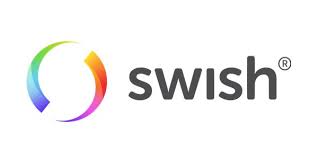
Dan Nilsson på ehandel.se skriver följande uppdatering om Swish:
Vi kan nu avslöja den exakta tidsplanen för Swishs företagstjänster och att det inte bara är e-handelstransaktionerna man vill ta över, utan i förlängningen alla mobila betalningar.
Swish tar marknadsandelar i det svenska betallandskapet, trots att inga integrationer finns tillgängliga. I mitten av maj hade Swish 270 anslutna e-handlare som erbjöd betalning med Swish och siffran har fortsatt öka i samma takt, det ansluter sig cirka en handfull e-handlare varje vecka och takten verkar inte mattas av.
Informationen från Swish själva är minst sagt knapphändig, gissningsvis har verksamheten inget eller begränsat eget mandat vilket gör det till trög process att få alla banker att prata samma språk och komma överens om framtiden. Nu kan vi dock avslöja att man har en gemensam plan och vad den innebär.
Alla mobila betalningar kan domineras
Vi har av naturliga skäl fokuserat mycket på hur detta kommer påverka e-handeln och även detta område är viktigt för Swish, men lika viktigt verkar mobila transaktioner överlag vara. I det material vi tagit del av gör man exempelvis ett case av transaktioner för betalning av bussbiljetter. Antagligen kan vi i förlängningen få se en stor del implementationer där WyWallet tidigare agerade, men där de lyckades relativt dåligt med att få konsumenternas uppskattning.
Efter att mobiloperatörerna släppte tjänsten till Payex finns det en öppning att gå in och kriga om de kunderna för Swish. Det som talar emot här är att Swish verkar sakna en egen organisation och agenda och därför blir väldigt trögrörliga, precis med samma upplägg som WyWallet indirekt. Skillnaden här är att man har 2,8 miljoner registrerade användare (slutet av maj), som friviligt skaffat tjänsten och utöver detta nästan 22.000 företag som gjort samma sak.
Det finns inget som talar emot att man skulle kunna gå in på betalningar inom detaljhandeln, där ingen ännu lyckats nå kritisk massa. Swish skulle med en lösning på plats kunna bli marknadsledande över en helg och på riktigt få igång de mobila betalningar i de fysiska butikerna. Utöver detta har man väldigt bra läge att dominera alla mikrotransaktioner inom exempelvis resor, parkering och liknande.
Lösningen för e-handel
Skillnaden mellan de integrationer som e-handlare redan har på plats idag och den nya lösningen är primärt att man gör det ännu enklare att betala med Swish. I dagsläget måste konsumenten efter lagd order skicka en betalning manuellt till handlaren med en referens som kopplas till aktuell order. Med ett riktigt API på plats kommer man skriva in sitt mobilnummer och sedan bara öppna Swish-appen i mobilen och signera köpet, sedan är det klart.
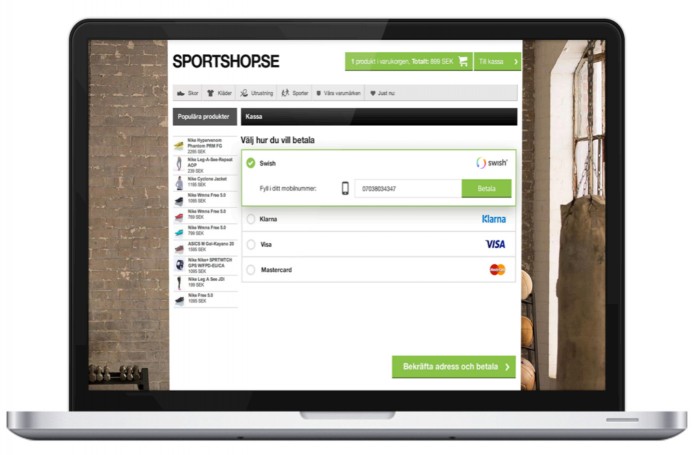
http://www.ehandel.se/artikelbilder/sehandel.jpg
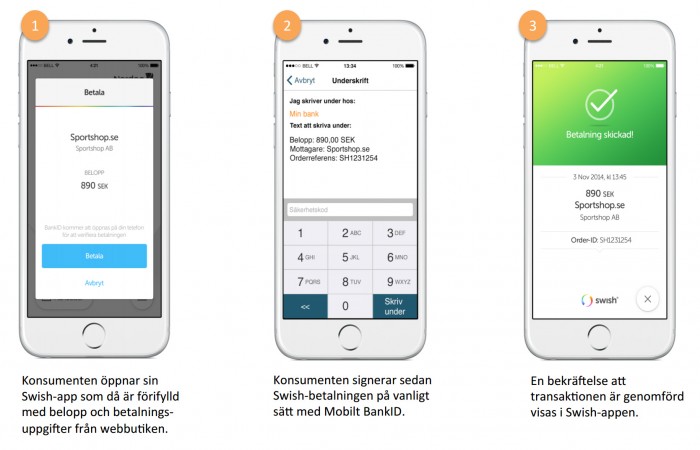
http://www.ehandel.se/artikelbilder/sehandel2.jpg
API:et utvecklas just nu
API:et arbetas det redan på och enligt vår information är det HiQ som driver arbetet med den tekniska lösningen. Det kommer vara möjligt att ha en egen API-integration direkt, via en e-handelsplattform eller via en betalleverantör. Gissningsvis är dialogerna igång både med de stora plattformarna och betalleverantörerna.
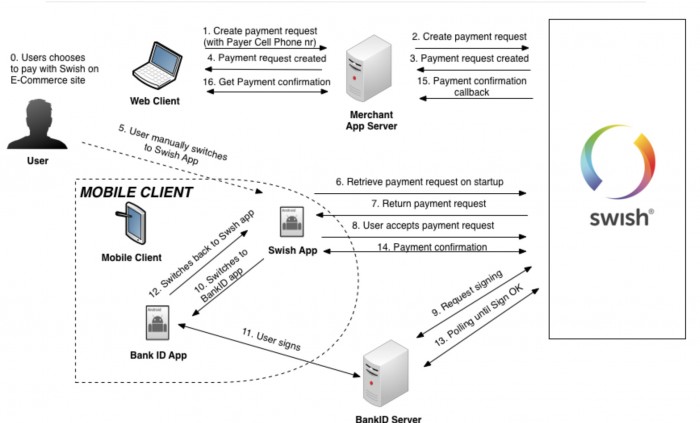
http://www.ehandel.se/artikelbilder/api.jpg
API:et är ett REST-api i JSON-format. Den dokumentation vi tagit del av tyder på ett mycket minimalistiskt och enkelt API som egentligen bara jobbar med två funktioner, skapa en betalningsbegäran och skapa en återbetalning. När betalningen är slutförd anropar Swish butikens egna callback-url och ger den underlag för att antingen sätta ordern som betald eller att något gick fel.
När blir detta verklighet?
Enligt Swish egna tidsplaner kommer man släppa en integrationsguide under juli, gissningsvis riktad mot större partners inom plattform och betalningar eftersom de flesta e-handlare inte har så långa integrationscykler. Sedan kommer det dröja till mitten av oktober innan man börjar jobba med integrationer. Fokus här lär ligga på stora kunder och de som kan sluta många slutkunder samtidigt.
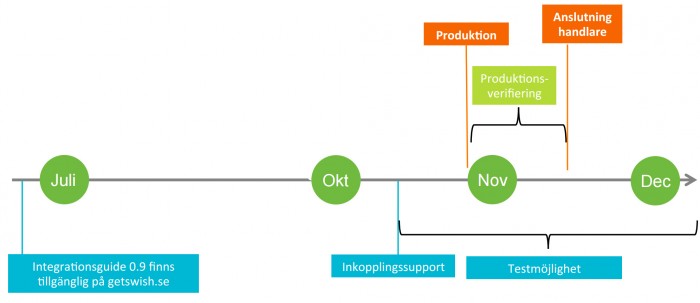
http://www.ehandel.se/artikelbilder/tidsplan.jpg
Enskilda e-handlare får gissningsvis vänta till i mitten av november innan det kan bli aktuellt att integrera. Detta förutsätter också att produktionsplanen håller, vilket nästan aldrig händer inom tekniska projekt.
Prisstrategi
Med nuvarande prissättning för tjänsten är man gissningsvis redan väldigt konkurrenskraftiga inom både e-handel och mobil handel. De flesta i branschen verkar vara överens om att denna prissättning kommer förändras när man har en anpassad produkt för företag på plats. Många har uttryckt sin oro över att man kommer förstöra sina egna konkurrensfördelar genom att bli giriga.
Nuvarande prissättning, som görs av respektive bank ser ut såhär:
| Bank | Per transaktion | Anslutningsavgift | Månadsavgift |
| Danske Bank | 2,50 kr | 475 kr | 50 kr |
| Handelsbanken | 3,00 kr | 495 kr | 49 kr |
| Länsförsäkringar | 1,00 kr -2,00kr* | 0 kr | 25 kr |
| Nordea | 2,00 kr | 0 kr | 0 kr |
| Swedbank | 1,50 kr – 2,00kr** | 0 kr | 0 kr |
* Beror på ordervärdet, 1,00kr upp till 100kr, sedan 2,00kr.
*Beror på vilket företagspaket du har hos banken.
Med den nya tekniska overheaden som inträffar med integrationssupport, samt stöd för större kunder kommer kostnaden för bankerna öka. Tjänsten kändes inte avsedd för företagskunder från början, känslan är snarare att detta är en efterhandskonstruktion när man såg vilket genomslag man fick i konsument till konsument-transaktionerna.
Priserna kommer gissningsvis öka, allt annat vore konstigt. Dock är bankerna förhoppningsvis medvetna om vilket prisläge konkurrerande betaltjänster inom e-handel har. Samtidigt vet man också att konsumenternas efterfrågan på tjänsten är hög, något man kan utnyttja i prissättningen. På lång sikt är det trots allt en del intäkter från kortinlösen som kommer gå förlorade till Swish. Även om de intäkterna via e-handel är en bråkdel av intäkterna via fysiska butiker, så kannibaliserar man på båda tjänsterna med Swish.
En annan intressant aspekt är frågan kring om man kommer standardisera prissättningen mellan bankerna, något som såklart blir lite komplicerat då man äger tjänsten tillsammans men lätt kan hamna i en kartell-liknande prissättning.
På sikt har Swish möjlighet att bli en e-handlares viktigaste betaltjänst, därför skulle vi inte bli förvånade om vi kommer få se en stor kundtillströmning från e-handlare till den bank som har bäst prissättning för Swish. Åtminstone kommer det vara väldigt vanligt att mindre och mellanstora e-handlare har dubbla banker. De stora e-handlarna kommer istället kunna förhandla ned priserna hos sin befintliga bank tack vare sin volym.
Hur stor andel av betalningarna kan man ta?
De e-handlare vi pratat med har allt från väldigt låga andelar av betalningarna upp till 10-12% av betalningarna via Swish. Dock får man ta i beaktning att detta är ett väldigt ovanligt betalsätt att stöta på hos en e-handlare idag. Även om enskilda konsumenter möter betalsättet ofta i privata transaktioner, betyder det inte att man enkelt börjar använda det vid nätköp. Det är dessutom inte ett lika lättanvänt betalsätt idag för e-handelstransaktioner, som det kommer bli när API:et är på plats.
När denna utrullning sker brett och de stora spelarna börjar acceptera Swish däremot, då kommer vi få se detta betalsätt ta stora andelar av e-handelsköpen. Vi skulle inte bli förvånade om de på 12 månader kan ta 10% av alla svenska e-handelstransaktioner och nästkommande år dubbla denna siffra.
Allting beror dock på hur bankerna förvaltar tjänsten, vi har sett hur man inte skulle göra i fallet med WyWallet, men man har i fallet med Swish alla förutsättningar för att lyckas. Nästa år kommer bli året då hygienkravet för vilka betalsätt en e-handlare erbjuder kommer utökas med ytterligare ett.
How to Get More Likes and Comments – The Science of Instagram:
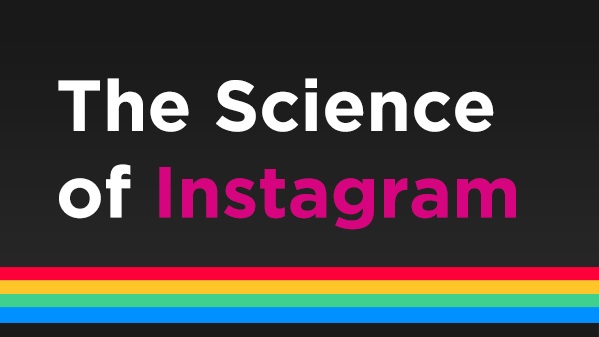
http://danzarrella.com
Based on DanZarella´s infographic, Juntae Delane writes in an interesting way about what attracts the eye and creates attention and popularity on instagram.
Brands have a hard time cracking Instagram because there is very little public data available. As they continue to build their Instagram audience, they may find themselves waiting to dive into the analytics until they reach that golden number of followers.
However that wait may now be over. Dan Zerrella has created an infographic that analyzed data from nearly 1.5 million photos and 538,000 users.
Here’s how you get more likes and comments on Instagram…
Key Insights
CPF is Comments-per-Follower.
LPF is Likes-per-Follower.
- More tags on a photo = more CPF and LPF.
- Photos with no filter have the highest LPF.
- Photos captioned with the world “like” get more LPF; photos captioned with “comment” get more CPF.
- Unsaturated photos have significantly higher CPF and LPF.
- Photos with faces have 35 percent higher LPF.
- Busier photos (those with more edges) have a higher LPF.
- Cooler colors have more LPF than warmer colors.
- Luminance – or brightness – has a higher LPF.
Infographic:

http://danzarrella.com



